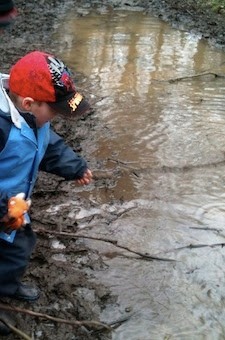At this time of the year, there are lots of puddles to meet and greet when out and about. Whilst children tend to like and play in puddles, I suspect they remain a secret source of fascination to many adults too. These suggestions are designed to help you respond to your children’s interest in the world around them. Look for the spontaneous opportunities to extend children’s learning when a puddle is discovered!
This post is in celebration of all those puddles. Every one. Everywhere….

1) Whirlpools
Swirl a stick around very quickly to make a whirlpool. Add a Lego person and see what happens…
2) Puddle jumping
Where do puddles form outside and why? On a really wet day, go for a puddle jumping walk. Think about the route which will provide you with the most puddles to jump in or over. Consider the clothes and footwear you will need to wear. At each puddle you encounter, decide whether you are going to:
- Jump over it
- Wade or splash through it
- Do something else
Make a note of your decisions and which worked best. Become an expert in puddle jumping.
3) Build a little boat
Find material which floats, such as bark. Leaves threaded onto twigs make good sails. How can you make the boat move from one side of the puddle to the other?
4) Shrinking puddle art
On a hot day, draw a line around the edge of a puddle on a hard surface with a stick or a piece of chalk. Go back a while later and see if the puddle has shrunk. If you do this every hour you can keep drawing around the puddles. Draw funky lines and patterns between the rings.
If you only have puddles in natural places, then use pieces of string to mark the edges of the puddle. Decorate with natural materials lying nearby between the pieces of string.
Does the size of the puddle affect the speed at which it shrinks? Is there anything you can do to speed up the process of evaporation?
5) Sing a song of puddles
Invent a puddle song and dance to do around a puddle. For example “The Hokey Cokey” song where you put your right foot in, your right foot out, etc.
6) Puddle splash
Try and splash all the water out of a puddle. How long does it take? What tactics work best?
7) Stone drops
Drop a flat stone into a clear deep puddle. Watch it sink. Now find some smaller stones and see if you can get one to land perfectly on top. Is there any particular size or shape of stone which works best for this activity?
8) The biggest splash
Many children enjoy trying to make a big splash. Is this about jumping with force, the size of your feet, the depth of the puddle or something else? How can this be safely investigated?

9) Stepping stones
Try finding ways of stepping through a puddle without your feet touching the water.
10) Do puddles have plugs?
If not, how can they be quickly drained? Where will the water be channelled to? What equipment is needed for you to undertake this job?
11) Icy puddles
What can you do with an icy puddle? Is it possible to safely walk on top? How will you find out? Can you break the puddle into shards of ice? What do birds do when they find ice-covered water?

12) It’s puddliscious
Have a good sniff of a puddle. How can you describe its smell? Is it possible to change the smell of puddle water in some way using only natural materials?
As usual, it would always be great to hear any other ideas you have for exploratory play around and in puddles. Meanwhile, have fun!
This blog post was originally published in February 2013.




















Some lovely ideas here Juliet. I especially like the the hokey cokey around the puddle – may try that myself
Great ideas, though at the moment I am glad to report no puddles anywhere in sight. But will store these ideas up for when they inevitably return!
Thanks for both your comments. I’m pleased you have no puddles Kierna after such seriously wet weather you’ve had recently. Everyone needs a dry spell from time to time.
Such great ideas. With four lovers of puddle playing (me, hubby and the two girls) we will be sure to try these out. thanks for sharing. 🙂
Laura – you are welcome – one can never have enough ideas about puddles – just great play places.
What about marking cm/inches onto the back of your wellies using a ruler and permanenet pen – then you can measure how deep the puddle is with your feet!
Puddle painting is good fun. Fill old juice bottles that have squeeze lids on with water and a little paint, use lots of different colours, see how the colours run together and change colour, see what patterns you can make. The children love to see what two colours together make and how the patterns change as they run together. Children at the school i work love this on a wet raining day.
Thanks Karen – this is a lovely addition to the suggestions. Thanks for taking the time to comment.